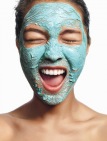Sem pa šla tudi sama malo gledat, kaj pomenijo (ker sem tudi pred parimi dnevi začela uporabljat ta tonik...); tukaj sem si nekaj skopirala:
butylene glycol Ă propylene glycol. Along with other glycols and glycerol, this is a humectant or humidifying and delivery ingredient used in cosmetics.
PEG compound. PEG stands for polyethylene glycol. Various forms of PEG compounds are mixed with fatty acids and fatty alcohols to create a variety of substances that have diverse functions in cosmetics, including surfactants, binding agents (to keep ingredients blended), stabilizers, and emollients. See polyethylene glycol. Ă polyethylene glycol. Also listed as PEG on ingredient labels, polyethylene glycol is an ingredient that self-proclaimed "natural" Web sites have attempted to make notorious and evil. They gain a great deal of attention by attributing horror stories to PEG, associating it with antifreeze (however, antifreeze is ethylene glycol, not polyethylene glycol), and there is no research indicating that PEG compounds pose any problem for skin. Quite the contrary: PEGs have no known skin toxicity and can be used on skin with great results (Sources: Advanced Drug Delivery Reviews, June 2002, pages 587?606; and Cancer Research, June 2002, pages 3138?3143). The only negative research for this ingredient indicates that large quantities given orally to rats can cause tumors, but that is unrelated to topical application.
Polyethylene, when it is not combined with glycol, is the most common form of plastic used in the world. It is flexible and has a smooth, waxy feel. When ground up, the small particles are used in scrubs as a gentle abrasive. When mixed with glycol, it becomes a viscous liquid. In the minuscule amounts used in cosmetics, it helps keep products stable and performs functions similar to glycerin. Because polyethylene glycol can penetrate skin, it is also a vehicle that helps deliver other ingredients deeper into the skin. It is even used internally in medical procedures to flush and clean the intestinal tract. See propylene glycol.
polysorbates. Fatty acids that are used as emollients and thickening agents in cosmetics. See fatty acid. Ă fatty acid. Substances typically found in plant and animal lipids (fat). Fatty acids include compounds such as glycerides, sterols, and phospholipids. They are used in cosmetics as emollients, thickening agents, and, when mixed with glycerin, cleansing agents. Fatty acids are natural components of skin and are components of a complex mixture that makes up the outermost layer protecting the body against oxidative damage (Sources: Free Radical Research, April 2002, pages 471?477; and Journal of Lipid Research, May 2002, pages, 794?804). Fatty acids can help supplement the skin s intercellular matrix. See natural moisturizing factors.
sodium salicylate. Salt form of salicylic acid (BHA). Because it is not the acid form of salicylate (i.e., salicylic acid), it does not have exfoliating properties.
glycolic acid. See AHA. Ă AHA. Acronym for alpha hydroxy acid. AHAs are derived from various plant sources or from milk. However, 99% of the AHAs used in cosmetics are synthetically derived. In low concentrations (less than 3%) AHAs work as water-binding agents. At concentrations over 4% and in a base with an acid pH of 3 to 4, these can exfoliate skin cells by breaking down the substance in skin that holds skin cells together. The most effective and well-researched AHAs are glycolic acid and lactic acid. Malic acid, citric acid, and tartaric acid may also be effective but are considered less stable and less skin-friendly; there is little research showing them to have benefit for skin.
AHAs may irritate mucous membranes and cause irritation. However, AHAs have been widely used for therapy of photodamaged skin, and also have been reported to normalize hyperkeratinization (over-thickened skin) and to increase viable epidermal thickness and dermal glycosaminoglycans content. A vast amount of research has substantially described how the aging process affects the skin and has demonstrated that many of the unwanted changes can be improved by topical application of AHAs, including glycolic and lactic acid (Sources: Cutis, August 2001, pages 135?142; Journal of the European Academy of Dermatology and Venereology, July 2000, pages 280?284; American Journal of Clinical Dermatology, March-April 2000, pages 81?88; Skin Pharmacology and Applied Skin Physiology, May-June 1999, pages 111?119; Dermatologic Surgery, August 1997, pages 689?694 and May 2001 pages 1?5; Journal of Cell Physiology, October 1999, pages 14?23; and British Journal of Dermatology, December 1996, pages 867?875).
sodium PCA. PCA stands for pyrrolidone carboxylic acid. It is a natural component of skin that is also a very good water-binding agent. See natural moisturizing factors.
sodium lactate. The sodium salt of lactic acid. Used primarily as a water-binding and buffering agent (to adjust a product?s pH value).
allantoin. By-product of uric acid extracted from urea and considered an effective anti-irritant.
Avena sativa. Oat plant. Oat extract can have anti-irritant and anti-inflammatory properties (Source: Skin Pharmacology and Applied Skin Physiology, March-April 2002, pages 120?124).
... itd.

































  Deluje proti odmrlim celicam na koži, ki povzročajo videz utrujene kože in zamašene pore. Kolikor se spomnim, ni nič komedogena.
 Deluje proti odmrlim celicam na koži, ki povzročajo videz utrujene kože in zamašene pore. Kolikor se spomnim, ni nič komedogena.





 ; sem ravno hotela vprašat kakšna je razlika med tema dvema kremicama.
; sem ravno hotela vprašat kakšna je razlika med tema dvema kremicama.




 Lapsus,..zmanJšala
Lapsus,..zmanJšala